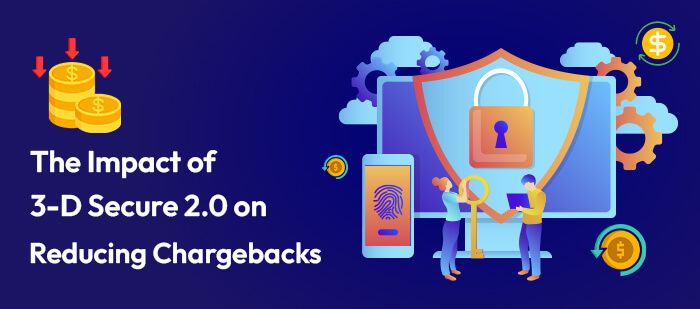
As online transactions continue to grow in popularity, so does the risk of chargebacks for merchants. These chargebacks not only result in financial losses but also create a negative impact on a business’s reputation. However, with the introduction of 3-D Secure 2.0, there is hope for merchants to reduce the occurrence of chargebacks significantly.
This new version of 3-D Secure, a security protocol for online payments, brings advanced features and enhanced security measures that aim to provide a smoother and more secure online shopping experience for both consumers and merchants. In this blog post, we will discuss the impact of 3-D Secure 2.0 on reducing chargebacks and how it can benefit businesses in the long run.
Understanding Chargebacks and Their Impact on E-commerce
Chargebacks, in the realm of e-commerce, occur when a customer disputes a transaction, leading to the forced return of funds from the merchant to the cardholder. While originally designed as a consumer protection mechanism against fraud and unauthorized transactions, chargebacks have evolved into a significant challenge for online retailers.
The impact of chargebacks on e-commerce extends beyond just financial losses. Merchants face increased processing fees, potential loss of merchandise, and additional operational costs associated with disputing chargebacks. Furthermore, a high rate of chargebacks can lead to higher payment processing fees or, in severe cases, the termination of the ability to accept credit card payments.
This not only affects a merchant’s bottom line but also its reputation among consumers and payment processors. The adverse effects underscore the necessity for advanced security measures like 3-D Secure 2.0, which are specifically designed to mitigate these risks by authenticating transactions more effectively and reducing the likelihood of fraudulent chargebacks.
Some Related Blogs
- Visa Chargeback Fee: An Essential Breakdown for Consumers
- Customer Returns: A Blessing in Disguise
- Unlocking the Features of Visa Account Updater
- Card Security Code: Your Last Defense Against Fraud
An Introduction to 3-D Secure 2.0 Technology
3-D Secure 2.0 represents a significant evolution from its predecessor, aimed at modernizing the security of online transactions. It’s a protocol that provides an extra layer of authentication during the payment process, making it harder for unauthorized users to fraudulently use credit cards online.
Unlike the first version, 3-D Secure 2.0 leverages richer data exchange, allowing for a more seamless and less intrusive verification process. This means that consumers can complete their purchases without being redirected to authenticate their transaction, a common friction point that often led to abandoned carts under the first iteration of the technology.
The update also introduces the capability for merchants and issuers to share more data about the transaction, enabling a more informed authentication decision without necessarily interrupting the shopper. This not only enhances the user experience but also significantly reduces the instances of fraud. With the adoption of machine learning and advanced algorithms, 3-D Secure 2.0 is smarter in detecting and responding to potential fraud in real-time, offering a robust mechanism for protecting both merchants and consumers in the digital marketplace.
How 3-D Secure 2.0 Reduces Chargebacks
3-D Secure 2.0 plays a pivotal role in reducing chargebacks by incorporating enhanced authentication processes that accurately verify a customer’s identity before a transaction is approved. This sophisticated approach leverages a wide array of data, including transaction history, device identification, and even behavioral biometrics, to assess the risk of fraud in real-time. By doing so, it significantly diminishes the likelihood of fraudulent transactions, which are a common cause of chargebacks.
![]()
Email us anytime!
Email customer service 24/7
![]()
Call us anytime!
Reach customer care 24/7 at +1 (888) 901-8653
When customers are required to authenticate their purchases through methods that are seamlessly integrated into the shopping experience, it not only deters unauthorized users but also ensures that legitimate transactions proceed without hindrance. This heightened level of security gives issuing banks less reason to reject transactions, thereby reducing the incidence of chargebacks initiated due to suspected fraud.
Furthermore, the transparency and data sharing facilitated by 3-D Secure 2.0 allow merchants to present stronger evidence in disputes, improving their chances of winning chargeback representments. This collaborative effort between consumers, merchants, and issuing banks creates a more secure and trustworthy e-commerce ecosystem, effectively minimizing the occurrence and impact of chargebacks on merchants.
The Benefits of Implementing 3-D Secure 2.0 for Merchants
Adopting 3-D Secure 2.0 offers numerous advantages for merchants aiming to enhance their e-commerce platforms’ security and efficiency. One of the most significant benefits is the substantial reduction in chargeback ratios, which directly contributes to improved profitability.
This is achieved through the advanced authentication methods that verify transactions with greater accuracy, thereby lowering the instances of fraudulent chargebacks. Additionally, by minimizing the need for manual reviews of transactions, merchants can streamline their operations and reduce associated administrative costs.
Another key advantage is the potential increase in customer trust and loyalty. When shoppers feel confident that their online transactions are secure, they are more likely to return to the same merchant for future purchases. This secure environment not only boosts consumer confidence but also enhances the overall brand reputation in the competitive online marketplace.
Furthermore, compliance with 3-D Secure 2.0 can lead to more favorable processing rates from payment providers, as the risk of fraud is significantly mitigated. This can result in substantial savings for merchants over time, further emphasizing the financial incentive to adopt this advanced security protocol. Overall, the implementation of 3-D Secure 2.0 represents a strategic investment for merchants, promising not only enhanced security but also operational and financial benefits.
Navigating the Challenges of 3-D Secure 2.0 Implementation
Implementing 3-D Secure 2.0 can come with its set of challenges for merchants. One primary hurdle is the initial integration process, which may require significant updates to existing payment systems.
This technological shift demands a thorough understanding of the new protocol and possibly the assistance of IT professionals to ensure a smooth transition. Additionally, educating customers about the new authentication steps is crucial to prevent confusion and reduce the risk of abandoned transactions.
Some customers might perceive additional security measures as a hurdle, particularly if they are not accustomed to the extra layer of authentication. Merchants must strike a balance between enhancing security and maintaining a user-friendly checkout experience.
Communication plays a vital role in this aspect, as informing customers about the benefits of 3-D Secure 2.0, such as improved security and reduced fraud, can help in mitigating resistance. Another challenge lies in keeping up with the evolving fraud tactics.
While 3-D Secure 2.0 is equipped with advanced technologies to counteract fraudulent activities, merchants must remain vigilant and continuously update their systems in alignment with the latest security trends. Overcoming these challenges requires a commitment to customer education, investing in technology, and a flexible approach to adapting security measures as necessary.


